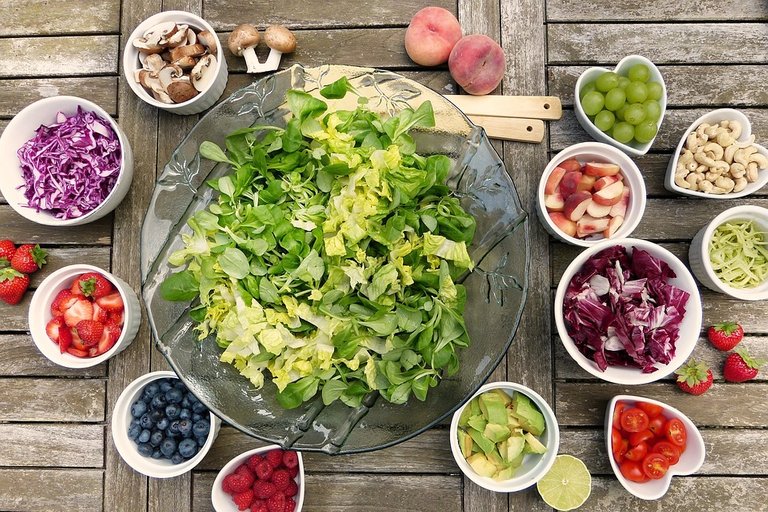Most foods provide the suitable environment or ecosystem for the rapid growth of microorganisms. From adequate organic matter, neutral or slightly acidic pH, to sufficient water content, it is an ideal ecosystem where bacteria fungi and so on can thrive.
Most homes buy foodstuffs in bulk and keep for future use. Due to some factors or the other, you may notice that your foodstuffs are getting spoilt. You kept wondering how could this be.

Foods are of different types based on their stability. We have the
*perishable foods with meat vegetables, fish, and eggs as examples [Source](https://pixabay.com/en/salad-fruits-fruit-berries-nuts-2756467/
- semi-perishable foods with potato and yam as examples
- staple foods with cereals and flour as examples.
Each of these foods has their stability period. You cannot expect a meat to still smell the same or look the same after some days. You need to preserve the foods especially perishable and semi-perishable foods.
Little wonder that your cereals last longer than the fish you bought yesterday in the market. You may also notice that some of the staple foods under moist condition do not have a long shelf life, therefore, it is safe to say that staple foods or semi-perishable foods under moist condition becomes perishable food.
Now let us look at some of the ways you preserve food.
First of all, why do you want to preserve food? As mentioned above people buy foodstuffs in bulk and keep for future use Would you want your money to go down the drain due to improper preservation method or you will consume unhygienic food.
The two main reason why you preserve foods are
- to increase the shelf life of the food
- to ensure the food is safe for human consumption
This will lead us to different food preservation methods and some of these methods are commonly utilized in our homes but how many know how the process works.
Heat
Heat is a common method used to preserve food. When you look at your canned food you wonder how the food doesn't get spoilt. Heat is used in the process of canning. It kills the microorganisms by altering the physical and chemical properties of their proteins. A typical example is when preparing your vegetable. After you have cut and wash the vegetable most people subject it to steam heat for 5 minutes or so then place it under warm running water. If you ask many people the reason why they do this, you will hear it is for the vegetable to get soft for consumption. This process is known as blanching and it destroys enzymes in the vegetable thus preventing further cellular metabolism. Canning is effective against Bacillus and Clostridium spores.
Low-temperature
This is another common practice. Users keep their leftover foods, perishable foods in refrigerators and freezers. This preserves the food for some time. Normally when you expose foods to low temperature, microorganisms growth and reproduction rate is reduced. This is due to the fact that the microorganism found in the food can survive in that food initial environment and that was why they were found there, you are now subjecting them to a much lower temperature. They will find it hard to survive there.
It is just like taking someone in the tropical region of West Africa to Iceland. Without adequate clothing, knowledge, and preparation the person is not going to survive. When food is kept in refrigerators at about 5<sup>o</sup>C the food will remain intact. However, in a freezer of about -5<sup>o</sup>C, the crystals formed in the freezer will tear and shred many microorganisms, therefore, leading to their death.
Osmotic pressure
Many people use this method too. For many, it is known as salting. People add salt to the perishable foods to preserve it thus preventing spoilage and increasing the food shelf life. Osmosis principle is applied here.
> It is the movement of a solvent across a semi-permeable membrane to a region of higher solute concentration. Source
By adding salt to preserve food it creates a hypertonic environment for the microbial cells. As a result of this hypertonic environment, water flows out of the cell, thus leading to the shrinking of the microbial cells. This means the cells won't be able to grow or reproduce. Fish, meat, and vegetable are preserved with salt while Honey, jams are preserved by their high sugar concentration.
More methods will be discussed in the next parts.
Posted from my blog with SteemPress : https://zoneboy.timeets.xyz/2018/07/05/why-do-you-preserve-foods-and-how-do-you-preserve-foods-1/
It's true that preserving food helps to increase the life span of the food preserved, it reduces the rate of food wasted, hence prevents wastage of money and also prevent health risk. This is a very enlightening write up, will anticipate for the next part. Thanks for sharing
Highly informative.
Reduced temperature is the best for me, nutrient are always kept intact
Every informative and educative. We need more of this bro, keep it up
Highly informative thanks for sharing
Now I guess I should not have any excuse for spoilt food. Educative post